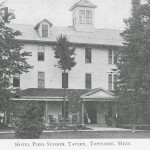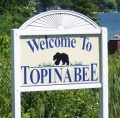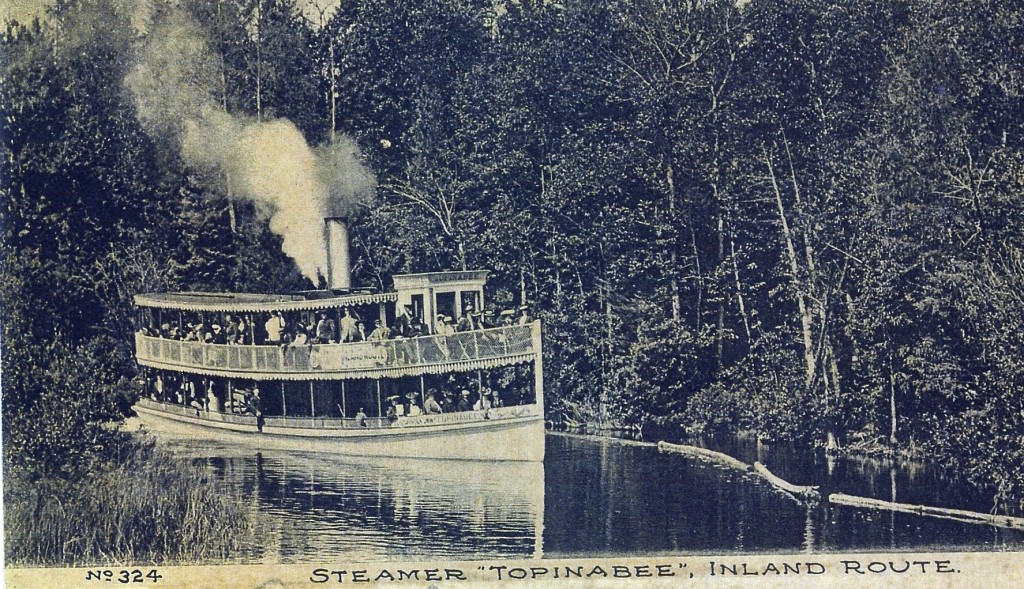History
Topinabee is small town with a very rich history.
 Modern history of the area began when settlers moved to the area in the 1880’s with the extension of the railroad to what is now Mackinaw City. Horace Pike developed a Hotel along the banks of Mullet Lake adjacent to the railroad tracks and people began to build homes in the area. Pike wanted to give the area a unique name and he named the area after an Indian Chief-Topinabee. The area continued to grow around the Lake with the hotel the center of activity.
Modern history of the area began when settlers moved to the area in the 1880’s with the extension of the railroad to what is now Mackinaw City. Horace Pike developed a Hotel along the banks of Mullet Lake adjacent to the railroad tracks and people began to build homes in the area. Pike wanted to give the area a unique name and he named the area after an Indian Chief-Topinabee. The area continued to grow around the Lake with the hotel the center of activity.
The town was founded in 1881 by businessmen from the Michigan Central Railroad. They were planning to extend their railroad from Gaylord, MI, approximately 35 miles south of Topinabee, to Mackinaw City, about 30 miles north of the town. They wanted a resort built on Mullett Lake for lodging during the lumber era. H.H. Pike built a hotel in 1881, it opened in 1882. The village grew from there. Pike named the community Topinabee after a chief of the Potawatomi Tribe.
The Inland Waterway draws in many tourists. Starting in Lake Huron, you can travel down the Cheboygan River to Mullett Lake, through the Indian River to Burt Lake, down the Crooked River to Crooked Lake and from there it’s a short walk over land to Little Traverse Bay in Lake Michigan. Having all these bodies of water so tightly packed in the area draws in all sorts of people; from fishermen, to beach dwellers, to water skiers and swimmers, Topinabee is a great place to be during the summer months. Because of this, there are many cottages available for rent in the area. Some more information about these cabins can be found
There were several springs in the area and the water from these springs was well know and trains took on water here due to the high quality of the water. There are several articles below about the history of the area including those about Chief Topinabee, Pikes Hotel, reminiscences by a long time resident and the development of the community into a center for four seasons of fun. The center of activity in the area continues to be the Inland Waterway that stretches some 48 miles from Crooked Lake to Lake Huron. Click on the sites below to learn more about the history of the area.
THE INLAND WATERWAY
The development of the Topinabee area was due to the inland waterway and the expansion of railroads to the area. The Inland Waterway consists of four inland lakes connected by three rivers that lead to one of the Great Lakes-Lake Huron.
Begining on Crooked Lake to the west the waterway travels 48 miles before entering Lake Huron. There is access to Pickeral Lake and the waterway crosses two of the largest inland lakes in Michigan-Burt and Mullett Lake before taking the Cheboygan River to Lake Huron and the Straits of Mackinaw.
The Inland Waterway is on of the finest waterways for boating, swimming, fishing and any type of water activities. Click on the link below to learn more about the history of the development of the waterway, the development of the communities along the miles of connected waterways and the impact on the surrounding areas.
TOPINABEE developed when the railroad opened the area to people from downstate and the Midwest. Horace Pike was one of the early settlers and he built a hotel in the area. He hoped to attract visitors to the area to visit the pristine waters of Mullett Lake and enjoy the many springs in the area that provided great water for the visitors. But first he need a name for the community He named the Community Topinabee after a famous Indian Chief. Click on the two sites below to learn more about the Chief that gave his name to this community. The sites below provide information of about Chief Topinabee.
THE LEGEND OF THE PIPE STEM OF TOPINABEE
THE RAILROAD AND TOPINABEE
The railroad was a key to the development of Topinabee. The passenger trains made it easy for people from downstate and Ohio to come to the area. Many built cottages in the area and came to them via the railroad. Click below to see articles on the railroad and the development of Topinabee. The first article is a history of the railroads in Topinabee and the second is memories of the railroad by Beth Chamberlain. The Chamberlain family were early settlers in Topinabee. The third site below has pictures of the railroad era.
.jpg) |
| Train at Topinabee 1881 |
The development of the Topinabee Hotel in 1882 by Mr. Pike brought many people to the area. They arrived via the railroad to enjoy the woods and water of the area and the excellent drinking water that came from the natural springs in the area. The hotel was a three story hotel with room for 40 guests and became a popular resort destination. A boat dock was added for the inland water route as well as a tavern. A casino was added for dancing and games. The railroad started regular schedules to the area in 1886. Mr. Pike subdivided 36 acres of land in the area in 1884 and sold lots for people to build cottages. Mr. Pike died in 1900 and the hotel was sold to E.R. Bailey. Who called the hotel Pike’s Summer Tavern. The hotel was destroyed by fire in 1917. It was rebuilt in 1918 and called the Hotel Topinabee. The Hotel was destroyed by fire again in 1928 and rebuilt the same year. Mr. Ed Maloney purchased the hotel in 1935 and he owned the hotel until he sold it to Irving ImOberstag in 1954. Fire damaged the hotel again in the 1960″s and was eventually razed in 1970. The development of the hotel was key to the growth of the Topinabee area.
The Topinabee Hotel before, during and after the fire.
Beth Chamberlains Memories of Topinabee in the 1920′s
The Chamberlain family were long time residents of Topinabee and Beth reminisces about her memories of the early years in Topinabee.
DID YOU KNOW……
As a relatively new resident of Topinabee, one of the first questions I had was what kind of name is “Topinabee”? And in the enlightened age of computers, that’s exactly where I went to find out.
Did you know Chief Topenebee was born in 1758 in his father’s village on the St. Joseph River in southern Michigan? His name means “he who sits quietly”, and he was the Chief of the Potawatomi Indians for over 40 years. During the War of 1812, he fought with the British and was present at the Dearborn Massacre August 15, 1812. (Although many of us “Michiganders” would automatically think of Dearborn as close to Detroit, this Fort Dearborn was at the site of what is now downtown Chicago, Illinois.) During the battle, Chief Topenebee was instrumental in saving the lives of a number of the settlers living there. After the war when most of the tribe relocated to Kansas, Chief Topenebee remained on his land grant in Michigan. He died on July 26, 1840, near Niles, Michigan. My internet information said the cause of death was a fall from his horse due to intoxication. Oh my! His body now lies near South Bend, Indiana. I couldn’t find any information about his grave location or markings, but I’ll keep searching for that and let you know.
NOW FOR THE REST OF THE STORY
In last month’s “Did you know…”, I told you I would continue my research about the burial location of Chief Topinabee. I contacted the South Bend Visitors and Information Bureau. I did hear back from them and after consulting their records and the expertise of a local historian this is what they told me.
They have no reference for a final resting place for Chief Topinabee. The local historian said, “The only marked grave is South Bend-proper is a mound of Potawatomi remains that is located in Cedar Grove Cemetery on the campus of Notre Dame.” He went on to say he is not saying he isn’t buried in South Bend but the location has been lost (or ignored) over time.
So now you know everything I know about Chief Topinabee! Jo Ann Baker
Steamer Topinabee
Did you know there was once the Steamer Topinabee cruising the Inland Water Route? It all started with a man named A.L. Hamill, a native of Cheboygan, better known as “Dolly”. In the very early 1900’s, he began as a railroad ticket broker then added the title Steamboat Agent. His office was located in Petoskey, in a book store next to the Post Office at the corner of Lake and Howard (or Park) Streets. “Dolly” was a member of the Guarantee Ticket Brokers Association of the United States. There are many references in history to the railroad* and its’ influence on the development of Topinabee, but the Steamers traveling the Inland Water Route added what was referred to as the “voyage of enchantment” through the “scenic grandeur of this beautiful chain of inland lakes and rivers”. The tour started every morning at 9:25 in Petoskey via the G.R. and I. Railroad traveling to Oden. In Oden you boarded the Steamer Topinabee. The trip was made entirely in daylight. In July of 1907 the stops along the way included Alanson, Sagers/Buckeye House, Columbus Landing, Indian River, Topinabee, Dodge’s Point/Club House, Hackmatac Inn, Cheboygan, Point aux Pines, Mackinac Island and St. Ignace. The brochure stated “The lower half of the INLAND ROUTE , from Oden to TOPINABEE is one of the navigation curiosities of the world and no visitor to Northern Michigan should miss the delightful trip on Hamill’s Inland Route Steamer”. The cost of a round trip ticket for the entire trip was $4.25! Prices varied for those who wanted to disembark along the way. No meals were served on the Steamers but passengers were allowed one hour at the Topinabee Hotel for dinner (lunch). Children over five and under twelve were half-fare and under five were free. Each adult traveler was allowed 150 pounds of free baggage and half-fares were allowed 75 pounds. Anything in excess of that was charged at a rate of 12 per cent. Transfer of any baggage was 25 cents for each piece.
The decor of the Steamer Topinabee is described as follows: “Her cabin is velvet carpeted, and with a fine piano, seats upholstered in plush, French plate mirrors, and costly draperies, every comfort is assured to the passengers. Just forward of the pilot house is a large, spacious deck, from which the tourist can command a fine view of the surrounding country, and which is elegantly furnished with folding chairs upholstered in leather and made especially for this steamer. Although the dangers of water travel are unknown to the Inland Route, still, to make her complete, the steamer is fully equipped with life preservers, life boats, fire buckets, and hose.”
*The Michigan Central Railroad, Mackinaw Division, gave Topinabee four through passenger trains daily, two north and two south. These trains had buffet parlor cars and Pullman sleepers from and to Detroit and Chicago, via Bay City and Jackson. “Tourist tickets” to Topinabee were available at all of the Michigan Central Railroad offices. Other railroad companies of that time connected at various stops along the way to other trains bound for Topinabee and Oden to board the Steamers for the INLAND ROUTE tours. The Topinabee Train Station had a Western Union Telegraph office and American Express office and “those who must have them are bothered with four daily mails”.
Life was good!
The Topinabee
Did you know there was once the Steamer Topinabee cruising the Inland Water Route? It all started with a man named A.L. Hamill, a native of Cheboygan, better known as “Dolly”. In the very early 1900’s, he began as a railroad ticket broker then added the title Steamboat Agent. His office was located in Petoskey, in a book store next to the Post Office at the corner of Lake and Howard (or Park) Streets. “Dolly” was a member of the Guarantee Ticket Brokers Association of the United States. There are many references in history to the railroad* and its’ influence on the development of Topinabee, but the Steamers traveling the Inland Water Route added what was referred to as the “voyage of enchantment” through the “scenic grandeur of this beautiful chain of inland lakes and rivers”. The tour started every morning at 9:25 in Petoskey via the G.R. and I. Railroad traveling to Oden. In Oden you boarded the Steamer Topinabee. The trip was made entirely in daylight. In July of 1907 the stops along the way included Alanson, Sagers/Buckeye House, Columbus Landing, Indian River, Topinabee, Dodge’s Point/Club House, Hackmatac Inn, Cheboygan, Point aux Pines, Mackinac Island and St. Ignace. The brochure stated “The lower half of the INLAND ROUTE , from Oden to TOPINABEE is one of the navigation curiosities of the world and no visitor to Northern Michigan should miss the delightful trip on Hamill’s Inland Route Steamer”. The cost of a round trip ticket for the entire trip was $4.25! Prices varied for those who wanted to disembark along the way. No meals were served on the Steamers but passengers were allowed one hour at the Topinabee Hotel for dinner (lunch). Children over five and under twelve were half-fare and under five were free. Each adult traveler was allowed 150 pounds of free baggage and half-fares were allowed 75 pounds. Anything in excess of that was charged at a rate of 12 per cent. Transfer of any baggage was 25 cents for each piece.
The decor of the Steamer Topinabee is described as follows: “Her cabin is velvet carpeted, and with a fine piano, seats upholstered in plush, French plate mirrors, and costly draperies, every comfort is assured to the passengers. Just forward of the pilot house is a large, spacious deck, from which the tourist can command a fine view of the surrounding country, and which is elegantly furnished with folding chairs upholstered in leather and made especially for this steamer. Although the dangers of water travel are unknown to the Inland Route, still, to make her complete, the steamer is fully equipped with life preservers, life boats, fire buckets, and hose.”
*The Michigan Central Railroad, Mackinaw Division, gave Topinabee four through passenger trains daily, two north and two south. These trains had buffet parlor cars and Pullman sleepers from and to Detroit and Chicago, via Bay City and Jackson. “Tourist tickets” to Topinabee were available at all of the Michigan Central Railroad offices. Other railroad companies of that time connected at various stops along the way to other trains bound for Topinabee and Oden to board the Steamers for the INLAND ROUTE tours. The Topinabee Train Station had a Western Union Telegraph office and American Express office and “those who must have them are bothered with four daily mails”.
Life was good!










